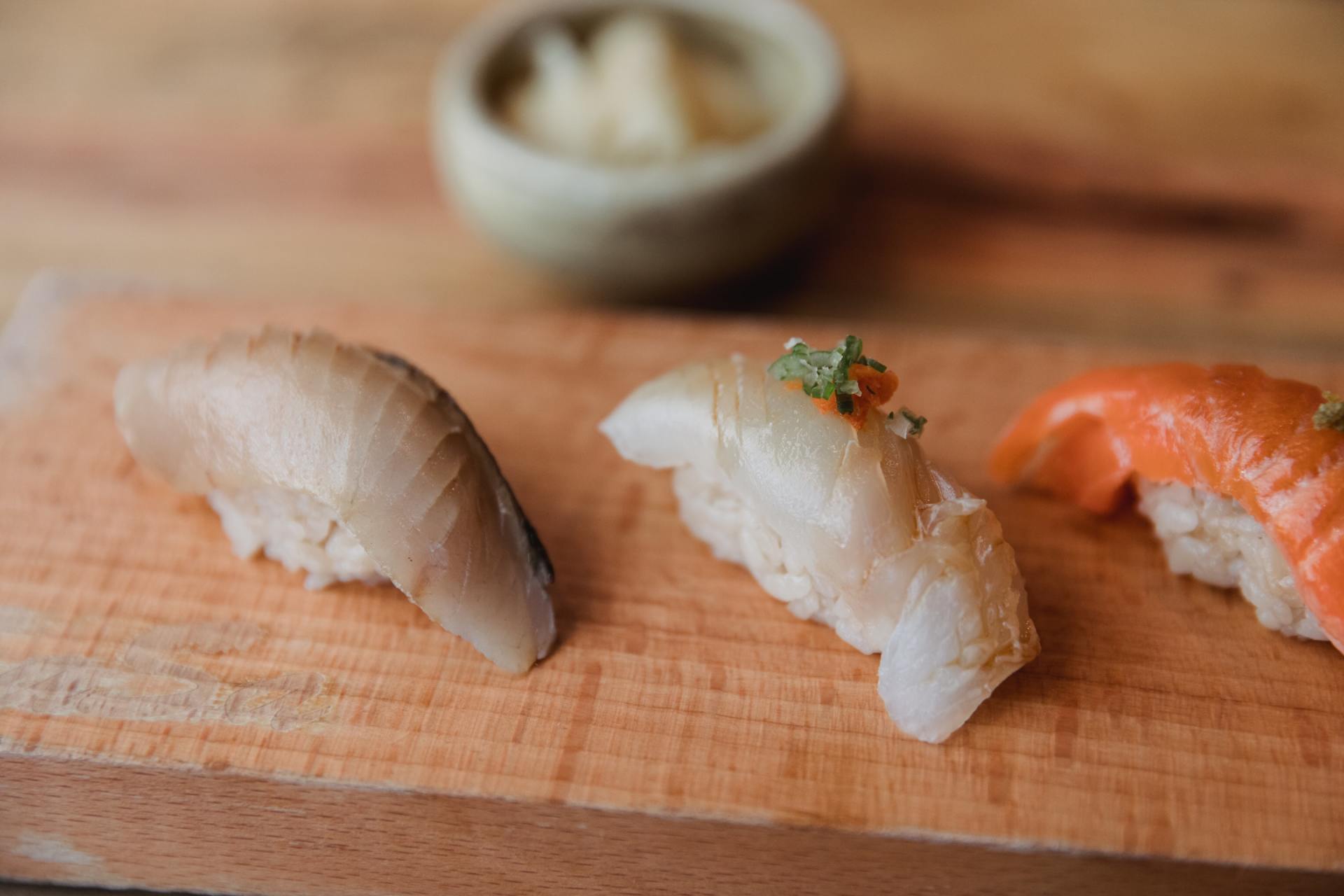Delightful World Of Lily Sushi: A Culinary Marvel For Food Lovers
Lily sushi is more than just a meal; it's an art form, a sensory experience, and a celebration of Japanese culinary tradition. This exquisite dish has captured the hearts of food enthusiasts worldwide with its delicate balance of flavor, texture, and presentation. Whether you're a sushi aficionado or a curious newcomer, lily sushi offers an enchanting journey into the world of premium sushi craftsmanship.
Rooted in the time-honored traditions of Japanese cuisine, lily sushi stands out for its meticulous preparation and attention to detail. From the selection of the freshest ingredients to the mastery of rolling techniques, every step in creating lily sushi is a testament to the skill and dedication of chefs. It's no wonder this dish has gained immense popularity in upscale restaurants and food festivals, becoming a symbol of sophistication and culinary excellence.
But what exactly makes lily sushi so special? Is it the unique combination of flavors, the stunning presentation, or the cultural significance it carries? In this comprehensive article, we will explore every aspect of lily sushi, from its origins and preparation methods to its health benefits and global influence. Whether you're looking to expand your knowledge or find tips on how to enjoy lily sushi like a connoisseur, you're in the right place!
Table of Contents
- What is Lily Sushi?
- Origins of Lily Sushi: A Culinary Heritage
- How is Lily Sushi Prepared?
- What Makes Lily Sushi Unique?
- Types of Lily Sushi: A Guide to Varieties
- Lily Sushi and Japanese Culture
- Health Benefits of Lily Sushi
- Lily Sushi vs. Traditional Sushi: What's the Difference?
- How to Enjoy Lily Sushi Like a Pro?
- Tips for Making Lily Sushi at Home
- Where to Find the Best Lily Sushi?
- Frequently Asked Questions About Lily Sushi
- Conclusion
What is Lily Sushi?
Lily sushi is a specialized variant of sushi that emphasizes artistry and high-quality ingredients. Its name often evokes an image of elegance, and it is typically crafted to resemble delicate floral patterns or intricate designs. Like traditional sushi, lily sushi includes a base of vinegared rice paired with fresh seafood, vegetables, or other toppings. However, it goes a step further by incorporating unique presentation styles and innovative flavor combinations.
This sushi type is often associated with fine dining experiences. Chefs spend years mastering the techniques required to create these intricate rolls. In many ways, lily sushi is a celebration of creativity, marrying traditional Japanese culinary practices with modern aesthetics.
Origins of Lily Sushi: A Culinary Heritage
The origins of lily sushi can be traced back to Japan, where sushi has been a cornerstone of the country's cuisine for centuries. While traditional sushi forms like nigiri and maki have long histories, lily sushi emerged as a modern interpretation aimed at elevating the visual and gustatory appeal of the dish.
It's believed that lily sushi began gaining popularity in the 21st century, initially as a niche offering in high-end sushi bars. Over time, it captured the imagination of chefs and food lovers alike, spreading beyond Japan to become a global phenomenon. The name "lily" is said to symbolize purity and beauty, qualities reflected in the dish's meticulous preparation and stunning presentation.
How is Lily Sushi Prepared?
Creating lily sushi is no small feat. The process begins with selecting the finest ingredients, including fresh fish, premium rice, and a variety of vegetables. Chefs often use custom-made tools to achieve the intricate designs that set lily sushi apart from other sushi types.
What are the key steps in making lily sushi?
- Ingredient Selection: High-quality ingredients are non-negotiable. Freshness is paramount, particularly for seafood.
- Rice Preparation: Sushi rice is seasoned with a mix of rice vinegar, sugar, and salt to achieve the perfect balance of flavor.
- Design Planning: Before rolling, chefs sketch out the design they aim to create, ensuring precision.
- Rolling and Cutting: The sushi is carefully rolled and sliced to reveal the intricate patterns within.
Each step is a blend of technical skill and artistic flair, making lily sushi a true masterpiece.
What Makes Lily Sushi Unique?
Lily sushi stands out for several reasons, from its visually stunning appearance to its innovative flavor pairings. Unlike traditional sushi, which often focuses on simplicity, lily sushi is all about pushing boundaries. Chefs experiment with unexpected ingredient combinations, such as truffle-infused soy sauce or edible gold leaf garnishes.
Can lily sushi be considered an art form?
Absolutely! Many chefs view lily sushi as a canvas for their creativity. The intricate patterns and vibrant colors are a feast for the eyes, making it as much a visual experience as a culinary one.
Beyond its artistic appeal, lily sushi also offers a unique taste experience, with each bite delivering a harmonious blend of flavors and textures. The attention to every detail, from the knife skills to the choice of serving plate, contributes to its uniqueness.
Types of Lily Sushi: A Guide to Varieties
Lily sushi comes in various forms, each with its own distinct characteristics. Some popular types include:
- Floral Rolls: Designed to resemble flowers, these rolls are as beautiful as they are delicious.
- Layered Sushi: A multi-tiered version that showcases different ingredients in each layer.
- Miniature Sushi: Bite-sized pieces that are perfect for tasting menus.
Each type offers a unique way to experience the artistry and flavor of lily sushi.
Lily Sushi and Japanese Culture
In Japanese culture, food is often seen as a form of expression, and lily sushi is no exception. Its emphasis on beauty and precision aligns with traditional Japanese values, such as respect for nature and a focus on mindfulness. Eating lily sushi is not just about satiating hunger; it's about savoring the moment and appreciating the craftsmanship involved.
Health Benefits of Lily Sushi
Like other types of sushi, lily sushi offers a range of health benefits. It's generally low in calories and high in nutrients, thanks to its use of fresh, wholesome ingredients. Common health perks include:
- Rich in Omega-3 Fatty Acids: The seafood in lily sushi is a great source of heart-healthy omega-3s.
- High in Protein: The combination of fish, tofu, and other ingredients provides a protein boost.
- Low in Saturated Fats: Unlike many Western dishes, lily sushi is light and minimally processed.
Lily Sushi vs. Traditional Sushi: What's the Difference?
While traditional sushi focuses on simplicity and flavor, lily sushi takes a more artistic approach. The main differences lie in:
- Presentation: Lily sushi is more decorative, often resembling art pieces.
- Ingredients: Lily sushi incorporates more unconventional and luxurious ingredients.
- Technique: The preparation process for lily sushi is more time-intensive and detail-oriented.
Both styles have their own charm, making them equally delightful in their own right.
How to Enjoy Lily Sushi Like a Pro?
Eating lily sushi is an experience in itself. To make the most of it, consider the following tips:
- Pair with the Right Beverage: Sake or green tea are excellent choices.
- Appreciate the Presentation: Take a moment to admire the artistry before digging in.
- Use Soy Sauce Sparingly: Overdipping can overpower the delicate flavors.
Tips for Making Lily Sushi at Home
While making lily sushi at home can be challenging, it's not impossible. Here are some tips to get started:
- Invest in Quality Tools: A sharp knife and bamboo mat are essential.
- Practice Basic Rolls First: Master simpler sushi forms before attempting lily sushi.
- Be Patient: Creating intricate designs takes time and practice.
Where to Find the Best Lily Sushi?
If you're not ready to make lily sushi at home, plenty of renowned restaurants specialize in this delicacy. Some of the best places to try include:
- High-end sushi bars in Tokyo, such as Sukiyabashi Jiro.
- Michelin-starred restaurants in major cities around the world.
- Local Japanese eateries that focus on artisan sushi.
Frequently Asked Questions About Lily Sushi
1. Is lily sushi suitable for vegetarians?
Yes, vegetarian versions of lily sushi are available, featuring ingredients like avocado, cucumber, and tofu.
2. How is lily sushi different from regular sushi?
Lily sushi emphasizes artistic presentation and often includes unique ingredient combinations.
3. Can I make lily sushi at home without professional tools?
While professional tools are helpful, you can improvise with basic kitchen items and still achieve good results.
4. Is lily sushi more expensive than traditional sushi?
Due to its intricate preparation and premium ingredients, lily sushi is often pricier than traditional sushi.
5. What are the most common ingredients in lily sushi?
Common ingredients include fresh fish, sushi rice, nori (seaweed), and various vegetables.
6. Are there any allergens in lily sushi?
Yes, lily sushi may contain allergens like seafood, soy, and sesame. Always check with the chef if you have dietary restrictions.
Conclusion
Lily sushi is more than just food; it's an experience that combines art, culture, and culinary innovation. Whether you're savoring it at a high-end restaurant or trying your hand at making it at home, lily sushi offers a unique way to appreciate the artistry and flavors of Japanese cuisine. With its growing popularity worldwide, there's never been a better time to explore this extraordinary dish. So why wait? Dive into the delightful world of lily sushi today!
- Umstead Nc
- Southfork Lodge
- Sunshine Thrift Store
- Pork Sandwich Near Me
- Dorothy Lane Market Centerville

Home

Home